Page 1 Daily News
by Gail Helmer
Thursday, April 12, 2001
PC News
New Warcommander Screenshots
CDV Software has released new screenshots for the upcoming strategy game Warcommander.The game is set in Europe during the Second World War. The gamer has to put together a task force consisting of up to 50 allied soldiers from 11 different types of units before going into action. Two campaigns from the point of view of US forces, with more than 30 gripping levels and additional special missions combine strategic puzzles and adrenaline pumping action. Release Date: Fall 2001.


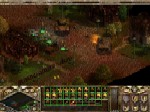


Free Graphics Techniques for Flight Simmers
Abacus Publication's latest book "Paint Shop Pro Power Solution" is a problem solver for the miriads of users who use this popular graphics software. This book presents helpful techniques in a simple and clear, step-by-step style. Power Solutions is written by, Scott Slaughter, an experienced graphics expert and author with five books to his credit. For the launch of his new book and to address the needs of the flight simulation community, Scott has prepared three bonus articles for using Paint Shop Pro with Flight Simulator and/or Combat Flight Simulator. These articles are written in the same style and format as his book. Scott has made them available online for readers to view and/or print. Click here for these FREE articles.
Sub Command Announced
Electronic Arts has announced that it will publish Sub Command. Sub Command allows gamers to control the world's deadliest submarines and utilizes an enhanced 3D engine to deliver what a press release calls a “realistic and immersive submarine simulation experience.” Set during the present, Sub Command allows gamers to oversee a nuclear powered submarine during times of war. Using a simple interface, people can navigate and maneuver their submarines into position to unleash a multitude of weapons including homing and super-cavitating torpedoes, among others. In addition, gamers have lethal anti-ship and land missiles at their disposal to engage targets above water.
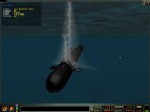


In Sub Command, gamers command three submarines -- 688[I] Class, AKULA Class and Seawolf Class -- and test their abilities in covert missions including "Under Ice" and "Sub Rescue". The separate campaigns for each submarine follow the performance of users and alter future missions based on their actions. Further, enemies that were not eliminated in previous encounters could re-enter the fight. People can engage enemies from 16 different countries. Sub Command also allows users to compete in co-op and head-to-head modes over the Internet that include U.S. vs. Russia missions and under-ice scenarios. Sub Command will be available for the PC in the summer of 2001. Click here to visit the official site.
Pearl Harbor: Zero Hour Announced
Simon & Schuster Interactive has announced its upcoming arcade-style flight combat game, Pearl Harbor: Zero Hour. The game is set during World War II, and players will get to dogfight with Japanese forces and go on bombing runs. Beginning with a real-time reenactment of the Japanese attack on Pearl Harbor, the game will progress through 10 missions drawn from Pacific campaign battles such as the Battle of Midway, Guadalcanal, and Okinawa. Players will choose from 14 types of historical aircraft, including the Corsair, the B-25 bomber, and the P-51 Mustang. The game will also include the complete audiobook CD Pearl Harbor, which is a novelization by Randall Wallace of the upcoming motion picture starring Ben Affleck and Cuba Gooding Jr. The film is scheduled for release in theaters on Memorial Day weekend. Pearl Harbor: Zero Hour is scheduled for release in mid-May for a suggested retail price of $19.95.
Cossacks: European Wars Gold
Strategy First and CDV Software announced today that Cossacks: European Wars' North American version has gone gold. Cossacks: European Wars takes players back in time to historical events of 16th to 18th Century Europe and immerses them into epic battles with hundreds, even thousands of units. Players pick one of sixteen countries that possess military forces in the infantry, cavalry, artillery and navy and march them into over 85 large-scale battles, most notably the Thirty Year War, the English Revolution, the Spanish Succession, and the Seven Year War.



The battles are huge and mesmerizing to watch with up to 8,000 units and over 80 different unit types to choose from. Players must orchestrate grand battles on a 3D landscape where they must take advantage of the entire environment -by commanding heights, hiding behind obstacles and capturing enemy installations - all in an effort to claim victory against the enemy. Single player campaigns recreate historical scenarios in which players must fulfill objectives from territory exploration to army formation, sometimes with limited forces. Multiplayer action over LAN and Internet allows for up to 8 players to challenge each other in Random Map and Historical Battle modes. Cossacks is scheduled for release April 24th.
Military News
EP-3 Crewmembers Return To The United States
Crewmembers from the United States Navy EP-3 aircraft involved in the April 1 accident with a Chinese F-8 aircraft depart from Andersen Air Force Base, Guam, April 12, on an Air Force C-17 Globemaster III. The next stop for the 24-crewmembers is Hawaii.
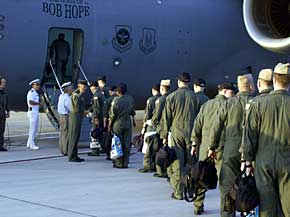
US Army Orders Four More TUAVs
United Industrial Corporation's AAI Corporation subsidiary has received an additional $19.4 million contract award on its ongoing programme to field the US Army's next-generation Tactical Unmanned Aerial Vehicle (TUAV) system. The award follows AAI's completion of a series of operational field tests and paves the way for a full-rate production contract for the TUAV program. This most recent award brings the current contract value to $83.6 million.
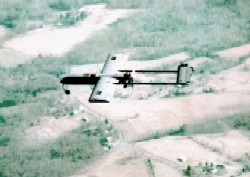
Since the initial contract award in December 1999, AAI has produced a TUAV system, based on its Shadow family of unmanned aerial vehicles, and delivered the first four low-rate initial production systems for testing at Fort Huachuca, Arizona.
The US Army has now exercised its contract options for delivery of four additional low-rate initial production systems. AAI anticipates a full-production contract to be awarded in the Fall, following completion of the Army's next phase of testing. The full-production contract may be for as many as 36 additional systems over the next four years, valued at more than $300 million.
Richard R. Erkeneff, President and Chief Executive Officer, commented, "We are delighted to have reached this significant milestone on the TUAV programme and look forward to proceeding on this important contract for the US Army. AAI's extensive experience with unmanned aerial vehicles has been a critical advantage on this key program, allowing us to move forward on an accelerated timetable to meet our customer's objectives. ''
The TUAV system is designed to provide brigade commanders with improved surveillance and reconnaissance capabilities.
ONR And Lockheed Martin Announce Advanced Hull Form Demonstration
Lockheed Martin's Naval Electronics & Surveillance Systems-Marine Systems (NE&SS) and the US Office of Naval Research (ONR) will cooperate to demonstrate ONR funded technologies which have been embodied in a revolutionary new ship called SLICE. The name SLICE refers to how the ship moves through rough waters.

The ship has an advanced hullform that provides increased stability and speed in high sea states. This unique hullform is a variant on SWATH (Small Water-Plane Area Twin-Hull) technology and has four separate underwater hulls that provide buoyancy, propulsion, and excellent hydrodynamic efficiencies. The ship is controlled by a patented PC-based canard and stabilizer steering and motion control system. The hullform has potential applications in both military and commercial markets.
"This is an exciting opportunity for the US Navy and Marine Corps because the visits allow us to demonstrate the products of our significant investments in advanced ship design technology, hydrodynamics, electric drive, advanced materials, sensors, electronics and other related disciplines," said Rear Adm. Jay Cohen, Chief of Naval Research.
Dale Bennett, vice president and general manager of Lockheed Martin NE&SS-Marine Systems in Baltimore said, "...we want to help ONR demonstrate the positive influence that science and technology programmes like the electric drive and SLICE will have on future ship designs, improving the crew's quality of life, and the new and exciting missions that will be possible using these technologies."
Wednesday, April 11, 2001
PC News
Air Command 3.0 Ships
Shrapnel Games announced today that the air traffic control simulation, Air Command 3, will begin shipping April 11th. Air Command 3.0 is a simulation of air traffic control. With the assistance of an actual Air Traffic Controller, Developer Joe Jaworski has balanced game play and realism to give the gamer a feel of what it is like to direct air traffic at a major international airport. Multiple difficulty levels, pilot digitized voices, pilot errors and miscommunications, and an airport editor provide for many hours of nail biting game play. Click here for more information.
Military News
Su-37 Super Flanker Video.
USNews.com has reported that Air Force officials pushing for the new F-22 jet have new ammo. They’ve videotaped the eye-popping hyperacrobatics of the new Russian Su-37 Super Flanker fighter jet, built with unique pivoting engines.

The video shows a somersaulting jet that turns course on a dime. Click here for the full story. Click here to download the video.
Hydraulic, software failures cause of V-22 crash.
A burst hydraulic line and defective computer software caused a V-22 Osprey aircraft to go out of control and crash in North Carolina during a training flight last December, a US Marine Corps' report says. Marine Gen. Martin R. Berndt announced the findings of his service's Judge Advocate General Manual Investigation into the cause of the crash at an Pentagon press briefing last week.
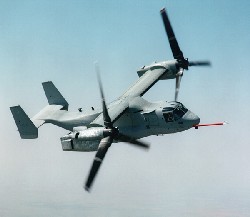
Four Marines were killed in December when their Osprey tilt-rotor aircraft crashed near Jacksonville, N.C. The twin-engined Osprey has unique prop-rotors that can be moved to point forward for level flight like a fixed-wing plane or upward to provide helicopter-like maneuverability. Reading from a prepared statement, Berndt, commanding general of the 2nd Marine Expeditionary Force at Camp Lejeune, N.C., said the causes of the crash were twofold and weren't attributable to aircrew error.
"Aviation mishaps are seldom caused by a single factor," Berndt said. "This one was no exception." He said a rupture occurred within one of the aircraft's three hydraulic systems used to move its engines and adjust the prop-rotors' pitch or angle. He said bundled wire within the aircraft's left engine compartment had chafed or rubbed against a titanium tube carrying hydraulic fluid.
The report noted that "based on the location of the ruptured hydraulic line in the nacelle area, it would have been extremely difficult to see any existing chafing on the hydraulic line during a routine inspection." "The wire bundle did not rub completely through the tubing," Berndt said, but enough chafing occurred to cause the tube to rupture under pressure. "This resulted in a total loss of hydraulic fluid in the No. 1 system in a matter of seconds. This hydraulic failure alone would not normally have caused an aircraft mishap." Berndt said the loss of hydraulic pressure caused a flight control system warning light to go on, which was accompanied by a warning tone.
"The published procedure for responding to such a failure is to press the primary flight control system reset button," he said. When the pilot pushed the reset button, a software flaw caused "rapid and significant changes to prop-rotor pitch," Berndt said, causing the aircraft to speed up and then slow down. The pilot pressed the reset button several times, and the aircraft became increasingly unstable with each press, he said. "The accelerating and decelerating of the aircraft every time that button was pressed was what caused the aircraft to stall and lose controlled flight," Berndt said.
Berndt said the Marine report recommends that Naval Air Systems Command and Osprey contractors conduct complete reviews of the aircraft's hydraulic line clearances, wire bundle placement, and computerised flight control system. The report also called for an investigation into the possible redesign of the Osprey's hydraulic system. Ospreys have been grounded since the December crash. Findings are pending for DoD inspector general crash investigation and a root and branch V-22 programme study by a blue-ribbon panel formed last December by then-Secretary of Defense William Cohen. "We will fly the aircraft or not fly the aircraft depending on the results," Berndt said.
UK Minister calls for action on ASRAAM delay
UK Defence Procurement Minister Baroness Symons has said that Matra BAe Dynamics (MBD) must achieve the performance levels set out in the original contract for the Advanced Short Range Air-to-Air Missile before it will accept the missiles into service. ASRAAM is due to be fitted to the RAF's Tornado F3 and Harrier GR9 aircraft, the Royal Navy's Sea Harrier FA2 and, eventually, to Eurofighter. But MBD has not yet delivered the performance level set when the missile was ordered.

Now the Ministry of Defence (MOD) has made it clear that it will only take delivery of missiles when it can be shown that an acceptable standard can be met. Baroness Symons said, "ASRAAM uses advanced, cutting edge technology which inevitably carries risk, and delivering the high standard of capability we need is a tough challenge for MBD. But I am determined that our pilots should get the missile they deserve to maintain air superiority into the future. Our new Smart Acquisition policy means tackling problems like this head-on, and working closely with companies to resolve them. That is what we are doing with MBD on ASRAAM.
MBD has been working to improve the missile, but needs time to achieve the required performance. The MOD says it needs to be confident that a clear and robust route has been set to reach the full operational capability required, and it intends to ensure that MBD devise the necessary solutions to identify this and enable a new in-service date to be set. The MOD hopes to agree the necessary actions with the company during the summer.
The MOD said that as a result of the shortfalls in this contract, the contract for Meteor, the new Beyond Visual Range Air-to-Air Missile for Eurofighter, which is expected to be signed in the summer, will include a series of key technological milestones which will have to be met, ensuring that any performance shortfalls are identified and tackled during the development programme.
Meteor is being built by a European consortium in which MBD is a major player. Until ASRAAM is accepted into service, the Tornado F3 will continue to be fitted with the Sidewinder missile, which is effective against the threat in current Gulf operations. The Harrier GR9, which is primarily used in the offensive support role, and the Sea Harrier FA2 will also continue to carry Sidewinder. The MOD says this delay will have no impact on Eurofighter's operational capability.
AH-1Z Continued Expanding Flight Tests
AH-1Z aircraft number 1, Zulu 1, the US Marine Corps' newest attack helicopter recently arrived at Naval Air Station Patuxent River to continue the flight test programme begun last December at Bell Helicopter Textron's Flight Research and Test facility in Arlington, Texas. Zulu 1 completed Phase I of development testing having flown a total of 59.9 flight hours. It also successfully completed harmonic vibration testing with 80 (72 Priority 1 and 8 Priority 2) different configurations of ordnance loaded on its weapon's stations.
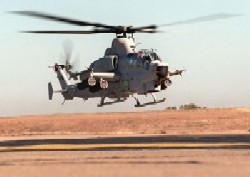
Three government and three company test pilots, all part of the H-1 Upgrades integrated flight test team (ITT), will begin Phase II of development testing at Patuxent River to continue expanding the flight envelope this month. This integration of the government and contractor flight test teams, with early operational test involvement, keeps flight test efficient, affordable and allows problems to be identified earlier and corrected before the helicopters go into OPEVAL.
This approach still captures all of the data required during dedicated contractor, DT, and OT testing, while embracing the acquisition reform initiatives to streamline testing. By taking advantage of the fact that the AH-1Z and UH-1Y share more than 85 percent of their mechanical and avionics components, linking the AH-1Z and UH-1Y testing allows a reduction in test time by eliminating redundant test flights between the two types of aircraft.
A total of five helicopters will be built for the flight test programme - three AH-1Zs, two UH-1Ys, as well as two non-flying test articles (one of each type). Zulu 2 and 3 and Yankee 1 and 2 are scheduled to arrive at NAS Patuxent later this year. The EMD flight test programme will complete by the summer of 2003 with OPEVAL scheduled to start that fall.
Tuesday, April 10, 2001
PC News
President of EA.com Dispells Rumors Regarding Air Warrior
A combination of events last month caught the attention of many people in the Air Warrior community. Various rumors and opinions have circulated. Therefore EA.com and its Kesmai Studio have released this letter from John Riccitiello, president of EA.com, on the subject.
To the Air Warrior Community,
Aces High V1.07 In Development
I am writing today to clarify some issues and concerns that you may have heard concerning the Electronic Arts' management of the Air Warrior franchise and the community that supports it.
First, I want to assure that Air Warrior III Millennium Version continues to be a priority for Electronic Arts. We've rededicated ourselves to improving that experience and providing more customer service and direct involvement with the community that supports it.
Recently, and following the acquisition of Pogo.com, EA announced a reorganization of its online business and related studios. In addition to integrating Pogo onto our site, we want to concentrate our development and customer service efforts on providing a better experience for products like Air Warrior and Ultima Online.
My concern was that we were developing too many new projects - competitive worlds and spin-offs that could have hurt our performance on core offerings. At the Kesmai studio level, we decided to focus our efforts on two projects: Air Warrior III: Millennium Version and Multiplayer BattleTech: 3025. Consequently, we cancelled plans for Air Warrior 4, which was not scheduled for release any time in the near future.
Going forward, we intend to deliver some enhancements to AW3MV that I think you're going to like. It's too early to offer a timeline for these improvements, but I think they'll reflect our commitment to the game and the community that supports it.
As you know, we also cancelled the volunteer program within the Air Warrior Community. Several Internet Service Providers and other online communities have taken similar actions due, in part, to legal challenges. However, we believe that the community is the cornerstone of the Air Warrior experience and we are evaluating alternatives that would allow players to contribute in a new, restructured program. Soon we hope to unveil details of how this new program will work.
Furthermore, we will provide a greater level of customer service in support of your community. Since EA purchased Kesmai last year, the number of employees working in the Virginia location has roughly doubled - many of these have been dedicated to customer service.
This is an exciting time for EA.com and Air Warrior. We are thrilled by what the team has accomplished so far and we look forward to bringing you many great enhancements on Air Warrior and other great EA games.
Sincerely,
John Riccitiello
President, EA.com
The HiTech Creations team has released some information on the upcoming Aces High version 1.07.
There are 3 major new systems planned for 1.07 not including new planes and the smaller development items. They are:
Military News
Three Airmen Among 16 Killed In Vietnam Helicopter Crash
Three active-duty Air Force people were among the 16 killed in a helicopter crash in central Vietnam April 7. Maj. Charles E. Lewis, 36, of Las Cruces, N.M., Master Sgt. Steven L. Moser, 38, of San Diego, Calif., and Tech. Sgt. Robert M. Flynn, 35, of Huntsville, Ala., were assigned to Joint Task Force-Full Accounting, based at Camp H.M. Smith, Hawaii. The helicopter crashed during a routine mission while preparing for a recovery operation involving unaccounted-for Americans lost during the Vietnam War, said Army Lt. Col. Franklin Childress, during a press conference April 7 at Camp H.M. Smith. Since 1985, American teams, with the full support of their Vietnamese counterparts, have conducted investigations and excavations in that country. As a result, the remains of more than 600 Americans have been recovered and identified. A board of officers will investigate the accident.
Lockheed Martin X-35B STVOL Engine Completes Critical Test
The Lockheed Martin Joint Strike Fighter propulsion team has completed accelerated mission testing (AMT) for the X-35B demonstrator's short-takeoff/vertical landing propulsion system -- one of the final steps before full flight certification. "With the completion of AMT we're moving swiftly toward STOVL flight," said Tom Burbage, executive vice president and general manager of the Lockheed Martin JSF program. "We've just demonstrated very clearly the benefits of the revolutionary shaft-driven lift fan propulsion system: a more benign ground environment and more lifting power with less engine strain and less ground surface erosion."
The AMT is a government-monitored durability evaluation in which the STOVL propulsion system hardware is subjected to twice the number of operating profiles it will encounter during flight testing. The speed with which the STOVL AMT was completed is unprecedented. All test objectives were met in less than half the time predicted. "With AMT completion, we've truly shown that this STOVL propulsion system is capable, reliable and ready for flight," Burbage said.
A team consisting of Pratt & Whitney, Rolls-Royce and Lockheed Martin engineers and technicians conducted the trials on a test stand at Pratt & Whitney's West Palm Beach facility. The unique propulsion system features a Pratt & Whitney JSF119-611 engine connected via drive shaft and clutch to a Rolls-Royce two-stage counterrotating lift fan. A thrust-vectoring rear nozzle and lateral "roll posts" also are manufactured by Rolls-Royce. In STOVL mode, the system produces nearly 40,000 pounds of vertical lifting force, providing ample hover thrust margin for safe STOVL operations.
During AMT, the STOVL propulsion system was continually cycled, representing 132 flight test missions. The operations were identical to those expected during subsonic and supersonic flight testing, ground testing and STOVL operations. At all times, the test team imposed bleed-air and horsepower extractions representative of X-35 requirements. The STOVL propulsion system was subjected to more than double the operating time/events expected during the X-35B STOVL flight demonstration program in terms of total accumulated engine cycles (TAC), total STOVL lift system operating time, and total number of lift-fan dynamic clutch engagements.
The final statistics are: 249 TACs, 115.6 hours of STOVL system operation and 171 dynamic clutch engagements. (In a typical mission, the propulsion system would operate in STOVL mode for less than 10 minutes.)
Remaining tasks for STOVL propulsion system hardware flight certification are system tear-down and inspection, and final flight-clearance documentation. STOVL software flight-qualification testing is under way, with expected completion in early May. STOVL propulsion system flight certification is anticipated for late May. Last month, the JSF X-35B completed non-flight hover pit testing, achieving full operational thrust and a better-than-predicted ground environment (exhaust temperatures and velocities near the aircraft).
New ASRAAM Missile Firing Tests On F-18
A new series of firing tests of Matra BAE Dynamics' ASRAAM air-to-air missile has begun validating their integration on an F/A-18 fighter aircraft The tests are being conducted at the US Naval Warfare Centre at Patuxent River in Maryland. The unguided firing tests were part of a series carried out by the US Navy for the Royal Australian Air Force (RAAF), who ordered the ASRAAM in 1998 to equip approximately sixty F/A-18 Hornet aircraft.
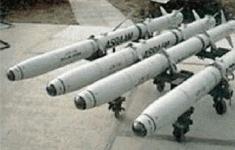
"When integration is complete on the Hornet and upon completion of the commissioning operations, Australia will have a highly credible, air superiority capability, based on the most advanced technology in terms of short range air-to-air missiles," said Jean-Pierre Talamoni, Matra BAe Dynamics' Director of Sales and Marketing.
Other firing tests for ASRAAM integration on Boeing's F/A-18 are scheduled to take place over the next few months. The integration of the ASRAAM on the F/A-18 (and the initial tests, will be handled by the US Navy. Additional firing tests and the technical and operational evaluation tests will also be performed outside Australia, but using RAAF aircraft.
The ASRAAM (Advanced Short Range Air-to-Air Missile) is a light missile (87kg) capable of engaging any aircraft, UAV, cruise missile, helicopter, etc, within the visual acquisition envelope of the pilot, as well as certain targets beyond visual range. The missile can be controlled by the aircraft's on-board radar, the sight on the pilot's helmetas well as operate in autonomous IR search and track mode.
The ASRAAM was developed by Matra BAe Dynamics under a British MoD contract to equip the fighter aircraft of the Royal Air Force. The missile can be fitted to the Tornado F3, the Harrier GR7 and the Eurofighter Typhoon of the RAF. Equipped with ASRAAM, the F/A-18, albeit in RAAF service, will be the first US aircraft in operational service to be equipped with a European air-to-air missile.
Rand Releases Joint Strike Fighter Study
The Department of Defense should stick with its winner-take-all strategy for near-term development and production of the Joint Strike Fighter (JSF) because it is the most cost-effective way to proceed. In addition, the Department should consider funding a potential future competitor that would be capable of developing and manufacturing the next major upgrade of the mission system equipment--the electronic eyes and ears of the JSF.
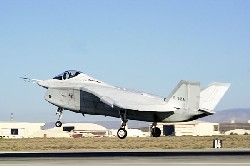

These are the two key policy findings in RAND's analysis of strategies for fostering competition during the production phase of the proposed $300 billion program. The fast-track study, requested by former Secretary of Defense William Cohen and conducted for the Office of the Undersecretary of Defense for Acquisition, Technology & Logistics, was launched last July, delivered in October and is being publicly released today.
The schedule for the JSF, conceived as a common jet fighter for the Air Force, Navy and Marine Corps, and projected to be one of the largest and most expensive acquisition programs in aviation history, calls for award of the development and production contract next fall. Teams led by Boeing and by Lockheed Martin are the finalists in the prime contractor competition. U.S. and U.K. forces hope to deploy some 3,000 of these aircraft by 2026.
In part because the JSF is the only new major fighter program planned for the next 30 years, senior DoD officials and members of Congress have voiced concerns about handing the massive contract to one company. RAND's National Defense Research Institute was asked to examine whether competition could reduce the overall cost of JSF production.
RAND researchers, led by senior analyst John Birkler, were asked to explore and identify opportunities and options to introduce competition during the production phase of the JSF. The principal criterion used was the likelihood that such competition would reduce the overall cost of JSF production. The researchers conducted in-depth interviews with members of both contractor teams and with the JSF program office staff to assess the costs and benefits of various competition strategies. They also examined DoD's experience with introducing competition in dozens of other weapons system procurement programs.
Birkler and his colleagues developed a unique "breakeven" model to gauge the likelihood that DoD would recoup its costs if it invested in a second JSF producer. They found that a competitive program involving two producers must result in 30 percent cost reductions across the board in order to cover the Department's up-front investment in establishing competition. Savings on that order would be "difficult, if not impossible" to achieve, they concluded.
Avionics hardware and software technologies are evolving rapidly, however, and several major mission systems upgrades can be expected over the life of the JSF. With that in mind, the researchers suggested that the DoD investigate establishment of a "shadow" industry team to begin developing more advanced system components and architectures and be prepared to compete for future upgrade programs.
The JSF programme is part of the root and branch review of the US Defense Department's major procurement programme ordered by the Bush Administration. There is considerable speculation amongst analysts that the JSF programme, as the least advanced of the four major aircraft programmes (F/A-18EF Super Hornet, F-22 Raptor, V-22 Osprey and JSF), as well as not having the single service support that each of the others has, is most vulnerable to cancellation.
Last Friday Boeing and Lockheed Martin were each awarded $30 million bridge contracts for continuing work in the JSF prototypes until September this year.
Black Hawk Upgrade To Go Ahead
The US Defense Department has given the go-ahead for a BLACK HAWK helicopter upgrade programme at Sikorsky Aircraft Corporation involving the modernisation of more than 1,500 aircraft during the next 20 years. The Defense Acquisition Board (DAB) has approved entry into Milestone B, System Development and Demonstration (SDD), for an upgrade programme for the US Army's BLACK HAWK fleet. A research, development, test and evaluation (RDT&E) contract award is expected later this month.
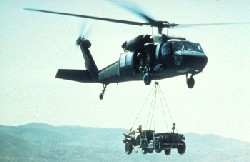
The upgrade programme is designed to extend the operating life of the BLACK HAWK fleet for an additional 25-30 years, as the current Army Aviation Modernisation Plan projects no replacement for the BLACK HAWK to enter service prior to 2025. Sikorsky began UH-60A BLACK HAWK production deliveries in 1978, making the oldest aircraft more than 23 years old. The current production BLACK HAWK is the more powerful UH-60L. To meet emerging Army requirements, the current plan is to first develop and field the new UH-60M configuration as the standard model of the BLACK HAWK.
"This modernisation programme will provide the Army with a robust utility aircraft capability well into this century," said Dean Borgman, president of Sikorsky. "By fiscal 2006, BLACK HAWK UH-60M production could be in full swing, with as many as 60 aircraft inducted for upgrades a year. This is a big win for the Army and for Sikorsky."
The Army has defined a requirement to increase the payload and range of the older UH-60A fleet to carry heavier equipment acquired since the inception of the BLACK HAWK programme and to meet its emerging doctrinal needs, including operating on the digital battlefield. The UH-60M will be fielded in the 2006 time frame and feature wide chord composite spar main rotor blades, a digitised 1553 bus-based cockpit and avionics suite, an advanced flight control computer, a strengthened fuselage and advanced infrared suppression.
The UH-60M will standardise the current fleet with the UH-60L General Electric T700-GE-701C engine and an improved durability main gearbox. The UH-60M will be built both as a retrofit to the older UH-60A and UH-60L fleet and as a new aircraft under future multi-year H-60 production contracts. The UH-60M configuration provides up to a 2,000-pound payload advantage and a 15-knot speed improvement over the UH-60A. It is expected to reduce maintenance costs by one-fourth of the current UH-60A expense. BLACK HAWK S-70 helicopter variants, including SEAHAWK naval derivatives, are serving, or are on order, with 25 international customers
Raytheon Awarded US Marine Corps CLAWS Contract
Raytheon Company has been competitively selected for the Complementary Low Altitude Weapon System (CLAWS) program and awarded a $9.5 million development and pre-production contract from the U. S. Marine Corps Systems Command. The 24-month program will produce two production representative CLAWS launchers to validate all performance and integration requirements.

CLAWS is an advanced air defense guided missile system launcher combining combat proven Advanced Medium Range Air-to-Air Missiles (AMRAAM) on the High Mobility Multipurpose Wheeled Vehicle. This expeditionary air defense system will complement current Marine Corps Avenger based systems by providing beyond visual range air defense against cruise missiles, unmanned aerial vehicles and other advanced threats.
"The CLAWS system gives Marines the air defense protection that's critical to our expeditionary force operation," said Capt. Peter Charboneau, deputy CLAWS program manager, Marine Corps System Command, Quantico, Va.
CAE USA To Build UH-60, CH-53 Simulator For Israeli Air Force
CAE's new operation in Tampa, Florida, CAE USA (previously BAE SYSTEMS Flight Simulation and Training), has been awarded a US$35 million contract by the Israeli Ministry of Defense to design and build aUH-60/CH-53 Helicopter Aircrew Weapon Systems Trainer (HAWST) for the Israeli Air Force (IAF).
CAE USA will serve as prime contractor on the programme with CAE of Montreal, Canada, as part of the team. The two companies had teamed to pursue this programme before CAE acquired BAE SYSTEMS Flight Simulation and Training.
The state-of-the-art HAWST will feature roll-in/roll-out cockpits to provide the IAF the ability to train both UH-60 and CH-53 crews in the simulator. When one cockpit is in use in the HAWST, the other cockpit can be operated in parallel as a flight training device. Other features of the UH-60/CH-53 HAWST will include an SGI Onyx 3400 visual system and SEOS 220x60 degree PANORAMA display. The simulator will be delivered and ready-for-training in early 2004.
The UH-60 Blackhawk is a light transport and utility helicopter used primarily for air assault, air cavalry, and aeromedical evacuation units. The CH-53 Sea Stallion is a medium lift helicopter designed to transport personnel, supplies, and equipment in support of amphibious and shore operations.
"The ability to pursue as a prime contractor US military programmes and programmes supported by US government foreign military funding was a key factor in our decision to acquire a US business," said Derek H. Burney, President and CEO of CAE. "This programme is a perfect example of the strategic importance this acquisition provides in enhancing our access to the broader defence market."
Monday, April 9, 2001
PC News
Flanker Beta V2.51 Released
The first Beta release of V2.51 is now available for downloading. In order to verify that several of the problems have been fixed, SSI is asking the community to provide feedback on their test results. SSI is mainly looking for reports from all of you that either verifies the six problems are fixed or not fixed. Click here for the full details on the beta release and download instructions.
Here is a recap of the six areas addressed:
Submitted for verification:
There are a number of problems that we have already found.
Please download the ZIP file and place the two files contained in the ZIP to your Flanker 2.0 directory. The files are FLANKER2.EXE and JOY2KEY.DLL. We recommend that you first save your original versions of these two files in another directory so that you can restore back to V2.5 if this Beta version 2.51 prevents you from playing at all. This will save your having to reinstall V2.5.
Once you have run this new version, please report your findings to the BETA V2.51 TEST RESULTS thread in the BUGS section of the Forum POST RESULTS HERE. Please do not report additional bugs unless you notice something severe or something that has been introduced with the new Beta version. SSI is mainly looking for reports from all of you that either verifies the six problems listed above are fixed or not fixed. Please do not post your wish lists or bugs that do not meet the category described above.
The file you need for the Beta 1 of V2.51 is located at:
V2.51 Beta 1
For those of you using FTP client software, Click here
Lock On: Modern Air Combat Screenshot.
SSI has released these screenshots from Lock On: Modern Air Combat (LOMAC). The F-16 will play a large role in the Lock On missions, Eagle Dynamics has revisited the F-16 3D model and texture. With a sharp of eye you will notice a new aircraft to Lock On.


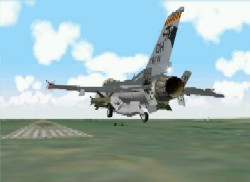

New Echelon Screenshots
Echelon puts the player in white-knuckle combat over lush alien landscapes and towering cities as a member of an elite fighting force facing a revolution on a colonial outpost. Featuring several branching campaigns and a well-wrought storyline, the player will have the ability to advance from Lieutenant to Commander during his/her battles and assume greater control over how each mission plays out. Click here to read COMBATSIM's preview.

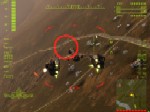




Graphsim Releases F/A-18 Korea Gold
Graphsim Entertainment has just announced the Gold edition of F/A-18 Korea for Windows®98/ME/2000. Utilizing the latest 3D technology, Korea Gold produces some of the most incredible graphics available on today's machines. The enhanced atmospheric effects and stunning texture-mapped 3D graphics create an unforgettable flight experience. Click here for the demo. Click here to read COMBATSIM's original review of F/A-18 Korea.
Waterloo: Napoleon's Last Battle Demo
Strategy First Inc.and BreakAway Games have announced a demo for their recently released real-time strategy game, Waterloo: Napoleon's Last Battle. Waterloo: Napoleon's Last Battle, based on the highly successful Sid Meier's Gettysburg engine, brings back to life the climactic battles between Napoleon and his archenemy the Duke of Wellington, in one of the most epic eras of all time - the Napoleonic Wars. The battlefield is also realistically re-created to display all of the significant terrain and landmarks such as Hougoumont Complex, La Haye Sainte and Plancenoit Church. With over 25 historical scenarios, the game features unique Orders of Battle, famous troop types, including dragoons, hussars, cuirassiers, as well as the Old and Young guard. Click here to download the demo.
Military News
Northrop Grumman Delivers Iwo Jima To U.S. Navy
The seventh ship in the USS WASP Class of multipurpose amphibious assault ships, IWO JIMA (LHD 7), was successfully delivered on schedule to the U.S. Navy by Litton Ingalls Shipbuilding, a subsidiary of Northrop Grumman Corporation, during a ceremony on April 6 at the shipyard. The LHD 7 is the last conventional steam propulsion ship to enter the Navy Fleet.
The shipyard/government team received praise from the Prospective Commanding Officer of LHD 7, Capt. John T. Nawrocki, USN, as well as Capt. Philip Johnson, USN, Supervisor of Shipbuilding, Conversion and Repair, Pascagoula. "You have delivered another great ship, the last of the great steamers. But your capital improvements, your new affiliation to Northrop Grumman and your experience with gas turbine surface combatants places you in a strategic position for the development of the next line of large deck amphibious ships," Captain Johnson stated. "Congratulations to Captain Nawrocki and his fine crew on achieving this milestone," said Ingalls Shipbuilding President Dave Wright. "As always, this was a total team effort between our shipyard, the Navy's Program Management Office, SupShip, Pascagoula and the IWO JIMA crew.
Now, the U.S. Navy/Marine Corps team will receive another excellent vessel with an Ingalls Shipbuilding quality stamp." IWO JIMA will be commissioned June 30 at Pensacola, Fla., before sailing to her homeport in Norfolk, Va.
Congress has provided $856 million for advance procurement, detail design and advance construction of one additional ship, LHD 8. Included in the LHD 8 design will be new gas turbine propulsion, electric auxiliaries, and a number of other improvements to reduce manning and life-cycle costs, and to improve war fighting capability.
JHMCS Flies On Boeing Super Hornet
The U.S. Navy recently began F/A-18E/F Super Hornet flight testing of the Joint Helmet-Mounted Cueing System (JHMCS), technology that allows airplane crews to aim weapons and sensors by looking at targets. The United States will install JHMCS on U.S.Air Force F-15, F-16 and F-22 fighters as well as the Super Hornet. A Boeing-Vision Systems International team is developing JHMCS. The U.S. Joint Program Office at Ohio's Wright-Patterson Air Force Base oversees the program.

JHMCS allows users to track and attack targets more quickly than enemies that don't have the capabilities it provides, greatly increasing combat effectiveness. It does so by synchronizing aircraft sensors with the user's head movements so they automatically point where the pilot looks, and displaying flight information on the inside of the helmet visor so data is always in view. When tied to a high off-boresight weapon like the AIM-9X missile, JHMCS allows a crew to attack airborne targets at extreme angles from their aircraft without having to maneuver into line with the target.
Three Super Hornet JHMCS flights have occurred, with about 10 more planned. Flight testing on the Super Hornet occurs primarily at Naval Air Warfare Center, Weapons Division, China Lake, Calif.
"I expect good results on the Super Hornet, just as we achieved on other airplanes," said Boeing JHMCS program manager Steve Winkler. "U.S. and allied crews that use JHMCS will set remarkable new standards of combat effectiveness."
The Navy last year placed an initial JHMCS order for its Boeing-built Super Hornets. Later this year, Boeing will begin delivering those systems. Also later this year, JHMCS will have its first flight test on an F-16.
Click Here for Printer Version
© 1997 2000 COMBATSIM.COM, Inc. All Rights Reserved.
